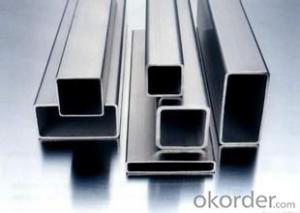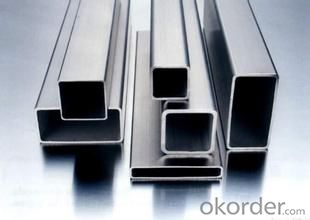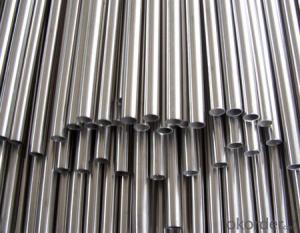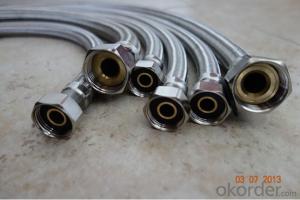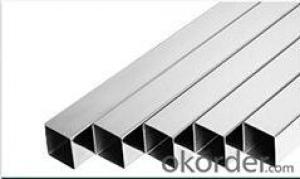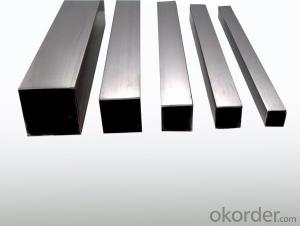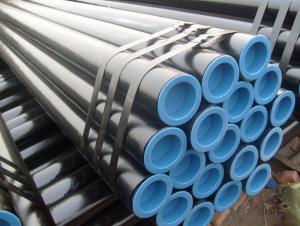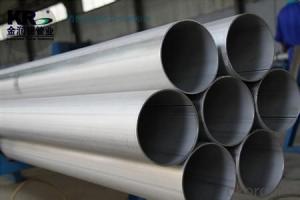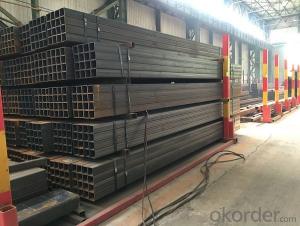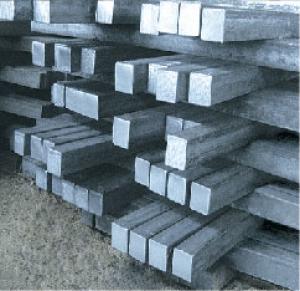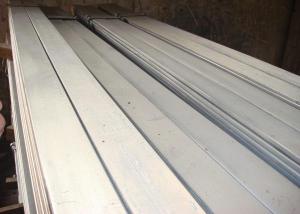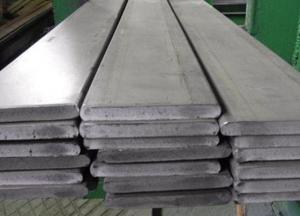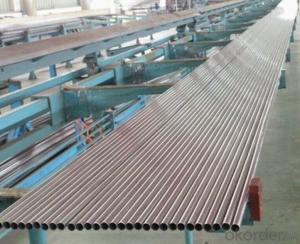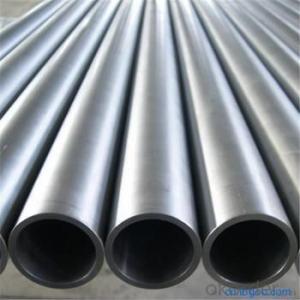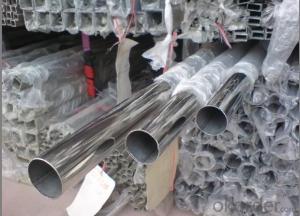Stainles stainless steel square tube
- Loading Port:
- Tianjin
- Payment Terms:
- TT OR LC
- Min Order Qty:
- 5 m.t.
- Supply Capability:
- 4000 m.t./month
OKorder Service Pledge
Quality Product, Order Online Tracking, Timely Delivery
OKorder Financial Service
Credit Rating, Credit Services, Credit Purchasing
You Might Also Like
| Size | (12-219) x (1-5) x (4000 - 13000)mm | |
| Material grade | 304, 304L, TP304, TP304L, 316L, TP316L, 321, F321, etc. | |
| Standard | ISO 9001/ ASTM A269/ A270/ A312/ A213, GB 14976/ GB 13296 | |
| Description | Process Method | Cold drawn and than cold rolled |
| Surface Finish | 2B,BA, Annealing and Pickling,Matt Finish or Satin Finish, Mirror Finish, Wire Drawing or Hairline Finish | |
| Ends Finish | Plain ends or Bevelled ends | |
| Test | Eddy current/ Hydrostatic/ Ultrasonic/ Intergranular Corrosion or according to customers' request | |
| Application | For use in the Petroleum, Smelting, Foodstuff, Power, Papermaking, Chemical, Medical Equipment, Aviation, Boiler Heat-Exchanger and other fields | |
| Packing | Each in PVC bags, bundles with knitted plastic bag, wooden cases or according to customers' request | |
- Q: Are stainless steel pipes suitable for fertilizer industries?
- Fertilizer industries find stainless steel pipes to be suitable. Stainless steel possesses a high level of corrosion resistance, a crucial characteristic for industries where pipes regularly encounter corrosive substances like fertilizers. Moreover, stainless steel pipes exhibit exceptional strength and durability, enabling them to withstand the demanding conditions of fertilizer production. Their smooth inner surface prevents the accumulation of sediments and impurities that might compromise fertilizer quality. Additionally, stainless steel pipes are effortless to clean and maintain, meeting the hygiene and safety standards mandated by the fertilizer industry. All in all, stainless steel pipes are an outstanding choice for fertilizer industries due to their corrosion resistance, strength, durability, and ease of maintenance.
- Q: Can stainless steel pipes be used for gas or oil transportation?
- Yes, stainless steel pipes can be used for gas or oil transportation. Stainless steel is known for its high resistance to corrosion and can withstand high pressure and extreme temperatures, making it an ideal choice for transporting gas or oil safely and efficiently.
- Q: Are stainless steel pipes resistant to pitting?
- Stainless steel pipes possess a high level of resistance against pitting. Pitting corrosion, a localized type of corrosion, leads to the formation of small holes or pits on metal surfaces. Stainless steel, consisting of chromium as its primary alloying element, develops a passive oxide layer when exposed to oxygen. This layer acts as a protective barrier that hinders further corrosion, thus ensuring stainless steel pipes' excellent resistance to pitting. Additionally, stainless steel pipes often incorporate other elements like molybdenum or nickel, which further improve their pitting resistance. Consequently, stainless steel pipes emerge as a dependable choice for applications where withstanding pitting corrosion is imperative, such as marine environments or chemical processing industries.
- Q: Stainless steel works. What saw can be sawed off?
- What is the best or bad, to the building materials market to find a store with a chainsaw to help cut or site also if things go to the talent market, a hydraulic, electric what, give him a little money he will help you cut out
- Q: What is the difference between 304J3 and 316J3 stainless steel pipes?
- The main difference between 304J3 and 316J3 stainless steel pipes lies in their composition and corrosion resistance properties. 304J3 stainless steel is a grade of stainless steel that contains 18% chromium and 8% nickel. It is known for its excellent corrosion resistance, high strength, and good formability. This grade is commonly used in various applications, such as food processing, chemical processing, and architectural applications. On the other hand, 316J3 stainless steel is a grade that contains 16-18% chromium, 10-14% nickel, and 2-3% molybdenum. This additional molybdenum content enhances its corrosion resistance, especially against chloride environments. As a result, 316J3 stainless steel is often used in more demanding applications, such as marine environments, pharmaceutical equipment, and coastal structures. In summary, the key difference between 304J3 and 316J3 stainless steel pipes is the composition and the subsequent corrosion resistance properties. While both grades offer good corrosion resistance, 316J3 stainless steel provides superior resistance in chloride-rich environments, making it suitable for more demanding applications.
- Q: Are stainless steel pipes suitable for swimming pool installations?
- Indeed, swimming pool installations can benefit from the use of stainless steel pipes. This material possesses exceptional durability and resistance to corrosion, rendering it a perfect selection for pools that are consistently exposed to water and chemicals. It is not prone to rust or corrosion, resulting in a lengthy lifespan and minimal upkeep. Furthermore, stainless steel pipes boast a sleek surface, mitigating the likelihood of algae growth and blockages. Moreover, they exhibit the capability to endure high pressure and temperature fluctuations, thus accommodating diverse pool systems. In summary, stainless steel pipes guarantee dependability, longevity, and efficiency, making them an apt choice for swimming pool installations.
- Q: Can stainless steel pipes be insulated with polybutylene?
- Polybutylene, a plastic material frequently utilized for water supply pipes, is not viable for insulating stainless steel pipes. These pipes, already remarkably corrosion-resistant, do not necessitate additional insulation for thermal purposes. In the event that insulation becomes essential for stainless steel pipes, alternative materials like fiberglass or foam pipe insulation may be employed.
- Q: Are stainless steel pipes resistant to chemical corrosion?
- Yes, stainless steel pipes are highly resistant to chemical corrosion.
- Q: What kind of welding machine is used for welding thin stainless steel plate and stainless steel square tube?
- But I've already attached a ban on reverse welding (the reverse side is a square tube frame)3. I want it to look good after welding.I was just 4. when reading practice a week of welding, can actually be said to have no understanding of welding after graduation, occasionally with ordinary welding iron will often appear in the weld the warning signs, the other is capable person, not a child, he should be responsible for his behavior. Irrigation can not go fishing? We must also be jointly and severally liable for an accident
- Q: How do stainless steel pipes compare to plastic pipes?
- Stainless steel pipes and plastic pipes have distinct characteristics that set them apart in terms of durability, flexibility, cost, and environmental impact. In terms of durability, stainless steel pipes are highly resistant to corrosion, rust, and extreme temperatures, making them suitable for both indoor and outdoor applications. On the other hand, plastic pipes are prone to degradation from UV exposure, chemical reactions, and high temperatures, which may lead to leaks or ruptures over time. Flexibility is another important factor to consider. Stainless steel pipes are rigid and inflexible, making them less suitable for installations that require bending or maneuvering around obstacles. Conversely, plastic pipes are highly flexible and can be easily bent or curved, allowing for easier installation in complex or tight spaces. Cost is often a deciding factor when choosing between stainless steel and plastic pipes. Stainless steel pipes tend to be more expensive upfront due to the higher cost of raw materials and manufacturing processes. However, they have a longer lifespan and require less maintenance, which can offset the initial investment. Plastic pipes, on the other hand, are generally more affordable but may require more frequent replacements or repairs, which can add up over time. Lastly, environmental impact is a crucial consideration in today's eco-conscious world. Stainless steel pipes are recyclable and have a long life expectancy, which minimizes waste and reduces the need for replacements. Plastic pipes, although recyclable to some extent, often end up in landfills due to their shorter lifespan and limited recycling capabilities. Therefore, stainless steel pipes are considered more environmentally friendly. In summary, stainless steel pipes offer superior durability, resistance to corrosion, and long-term cost-effectiveness. However, plastic pipes are more flexible, affordable upfront, and suitable for specific applications. Ultimately, the choice between stainless steel and plastic pipes depends on the specific needs, budget, and environmental considerations of the project.
Send your message to us
Stainles stainless steel square tube
- Loading Port:
- Tianjin
- Payment Terms:
- TT OR LC
- Min Order Qty:
- 5 m.t.
- Supply Capability:
- 4000 m.t./month
OKorder Service Pledge
Quality Product, Order Online Tracking, Timely Delivery
OKorder Financial Service
Credit Rating, Credit Services, Credit Purchasing
Similar products
Hot products
Hot Searches
Related keywords
